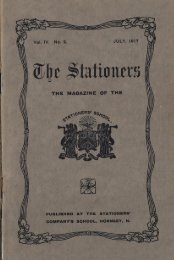OSAmag80
Create successful ePaper yourself
Turn your PDF publications into a flip-book with our unique Google optimized e-Paper software.
70th Anniversary of<br />
Operation Market Garden<br />
On D Day June 6th 1944 the three tanks and fifteen men of 4th<br />
Troop 'B' Squadron 4th17th Royal Dragoon Guards landed on the<br />
Normandy coast. Our amphibious DD tank (ambitiously named<br />
on the side 'Cooks Tour') had been swamped during the landing<br />
and had been replaced by a conventional diesel Sherman. Three<br />
months later we had reached Holland having motored 500 miles.<br />
We had been in action during the bitter fighting in Normandy,<br />
were involved in the crossing of the River Seine, carried out a<br />
recce of the City of Lille to be met by an ecstatic crowd in the<br />
Place de la Republique and been in action in Belgium. Out of the<br />
original fifteen crew and three tanks, seven of our comrades had<br />
been killed, two missing, three wounded and two paws, and had<br />
seven Sherman tanks destroyed by enemy action.<br />
The German West Wall fortifications, known as the Siegfried<br />
Line was 480 km long and ran opposite the French Maginot<br />
Line from Basle to Cleve. It was constructed to delay an offensive<br />
so that reserves could be brought forward and was a formidable<br />
obstacle with tank defences and block-houses.<br />
In order to outflank the German defence line an operation by<br />
Montgomery to establish a bridgehead across the Lower Rhine<br />
at Arnhem was endorsed by the supreme commander, Eisenhower,<br />
to commence 17th September 1944. Called Operation Market<br />
Garden it comprised a parachute offensive with ground support.<br />
The ground offensive, Operation Garden, was to commence at<br />
the Belgian-Dutch border, proceeding via Eindhoven, Uden, and<br />
Nijmegen to Arnhem, the front being only one road width wide.<br />
British XXX Corps was to attack down the road, with British 8th<br />
Corps and 12th Corps on either side of the narrow corridor<br />
being carved out by XXX Corps.<br />
The airboume offensive, Operation Market, was to take place at<br />
points along the same road, the US<br />
101 st Airborne Division dropping in<br />
the area of Zon, Veghel and Uden,<br />
capturing the bridges over the<br />
Wilhemenia Canal and the Zuid<br />
Willemsvaart Canal. The US 82nd<br />
Airborne Division was to capture the<br />
bridge over the Maas at Grave and the<br />
over the Waal at Nijmegen and to<br />
dominate the high ground known as<br />
the Groesbeek Heights between<br />
Nijmegen and the German border.<br />
The British 1st Airboume division<br />
was tasked to capture the bridge at<br />
Arnhem and to establish a bridgebead<br />
across the Rhine. All went horribly<br />
wrong however; the 1st Airborne was<br />
dropped too far away from the<br />
Arnhem Bridge. The main purpose of<br />
a parachute drop is surprise, but this<br />
was not achieved as the 9th and 10th<br />
SS Panzer Divisions were refitting in<br />
the Arnhem area. To add to the<br />
difficulties the radio connection<br />
between the commander Major-<br />
General R E Urquart and the 1st<br />
T h e O l d S t a t i o n e r - N o 8 0<br />
Sketch map 1: The Market Garden Plan<br />
17 September 1944 in Belgium<br />
Airbourne failed. He was trapped in a house for 24 hours to<br />
evade a German patrol and therefore losing command of the<br />
operation.<br />
The object of Garden was to meet up with and relieve the<br />
airbourne troops who had been dropped to capture the bridges at<br />
Grave, Nijmegen and Arnbem. We were to follow the Guards<br />
Armoured Division who was leading the assault. The problem of<br />
course, attacking on such a narrow front with a long tail back,<br />
was the possibility of flank attacks by the Germans cutting off<br />
the supply route and reinforcements. As we motored north alerts<br />
became frequent and it was necessary to stop and take up<br />
positions behind trees lining the road. The US 82nd Airborne<br />
had successfully taken the bridge at Grave so we pushed on to<br />
Nijmegen, which we reached without any difficulty.<br />
The bridge across the River Waalat Nijmegen<br />
We parked in the open square just before the bridge. The town<br />
was obviously short of food and we were besieged for anything<br />
we could spare. The Dutch Resistance put in an appearance<br />
solemnly parading around the square two Dutch girls with their<br />
heads shaved, who had consorted with the German troops. It was<br />
a pity the Resistance had nothing better to do. (During the<br />
liberation of Rugles in France the<br />
Resistance were shaving heads in the<br />
high street. One of our tank<br />
commanders told his gunner to fire<br />
the machine gun over the perpetrators<br />
to put a stop to it, but in error he fired<br />
the main gun scattering everyone at<br />
great haste.) Later when we had<br />
returned to Nijmegen I was detailed<br />
to pick up some potatoes from a<br />
nearby Nunnery. The nuns had taken<br />
the two girls into their protection and<br />
given them wigs to cover their shaven<br />
heads.<br />
It was decided to cross the river by the<br />
rail bridge. Whilst we were waiting to<br />
go across, our eo-driver was found<br />
wandering about with amnesia. The<br />
Squadron Leader sent him to casualty<br />
from whence he was invalided home.<br />
The Squadron pushed on with the<br />
Duke of Cornwall's Light Infantry<br />
riding on the tanks in an attempt to<br />
reach the Polish Airborne Brigade at<br />
Driel to the west of Arnbem. It was<br />
extremely hot and dusty. The column<br />
17















